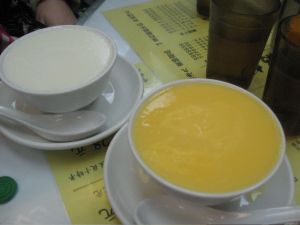Here is the long-awaited (not that I am implying anybody is waiting for it!) second half of the restaurant series in Hong Kong. This is 2623 words long, over the word limit for my current assignment on privatisation of health services. (seriously, how do they expect me to discuss such a complex issue indepth with such a constraint of word limit, when I can easily write so much about something as simple as eating!??)
Lamma Mandarin Seafood Restaurant (Peach Garden Seafood Restaurant 世外桃源海鮮酒家) (Lamma Island)
If you’re a nature lover in need of a respite from the metropolitan buzz of downtown Hong Kong, the outlying archipelago are the perfect sanctuaries. Only a short boat cruise away, peaceful scenery, meandering hiking trails, quaint villages, traditional farming fields, charming fishing boats, with not a car in sight and fresh seafood awaits you. Enchanting historical remnants of Hong Kong have been preserved in these isolated old-world islands.

Pretty ain't it?
One such island is Lamma Island 南丫島. Departing the ferry, you are greeted with a continuous strip of seafood restaurants, all overlooking the harbour with plastic dining tables and fluorescent lighting. Rows of fish tanks piled one on top of the other cover the shopfronts forming square mosaics, some even have underground pools, and I wonder if there have been anybody careless enough to step into them?! Competition is fierce among the restaurants, and the waiters always advertise (pester) passers-by.
The Rainbow Seafood Restaurant is traditionally the most eminent, with their windows adorned with a photo entourage of celebrities ranging from Joey Yung to Martin Yan, and I do remember last year, the meal I had was very delicious. However, my dad insisted that it was overpriced and so went to this restaurant instead, which has a very interesting name: (translated) Otherworldly Peach Garden Restaurant. We were lucky enough to procure a seaview table, and despite the discouragement of the waiter, we got the set meal for three (I didn’t know why they said the set meal isn’t good: later my aunty explained that of course they wanted us to order separately since they would make more profit!).

 The whole meal costed around $HK300+ from what I remember. It had several dishes, some of which I have forgotten. There was garlic and chilli prawns (prawns were so flavoursome!), deep-fried garoupa (amazing: super crispy batter with a tender meat), fried rice (most people can make fried rice, but only the skilled can make it taste really good), whole crab (sauce wasn’t anything special, but crab was fresh… I don’t like poking, prodding, cracking and sucking the meat out of the shell though!), and the standard dish of vegetables (lettuce I think). In the end, we finished off by ordering an abalone dish: $HK30 each abalone, which came in its shell with a simple sauce and dried tangerine peel. I didn’t think I would like it, but it was
The whole meal costed around $HK300+ from what I remember. It had several dishes, some of which I have forgotten. There was garlic and chilli prawns (prawns were so flavoursome!), deep-fried garoupa (amazing: super crispy batter with a tender meat), fried rice (most people can make fried rice, but only the skilled can make it taste really good), whole crab (sauce wasn’t anything special, but crab was fresh… I don’t like poking, prodding, cracking and sucking the meat out of the shell though!), and the standard dish of vegetables (lettuce I think). In the end, we finished off by ordering an abalone dish: $HK30 each abalone, which came in its shell with a simple sauce and dried tangerine peel. I didn’t think I would like it, but it was
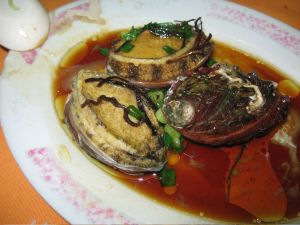
Abalone
so succulent yet chewy textured, and a wonderfully light seafood sweetness, complemented perfectly with dried peel (even though I usually hate that!). So if you’re looking for a fresh, exquisite seafood dinner, look no further than Lamma Island.
Food Republic (Tsim Sha Tsui and Taikoo Shing)
A chain of food courts that originates from Singapore, Food Republic is inspired by local hawker fare (Wikpedia, 2009): an impressive variety of ‘fast food’ stalls from a wide array of cuisines. Not surprisingly, there is HK cuisine and other regional varieties of Chinese cuisine, but also Japanese, Korean, Taiwanese, Indian… Typically, I spend over 30 minutes walking around trying to make a decision from the abundance of choices, especially because it seems like all the outlets are of high quality and relatively cheap.
Amos and I had been walking around the Art Museum in TST and figured this place would be great for a cheap feed. This time, I had Japanese pancake and 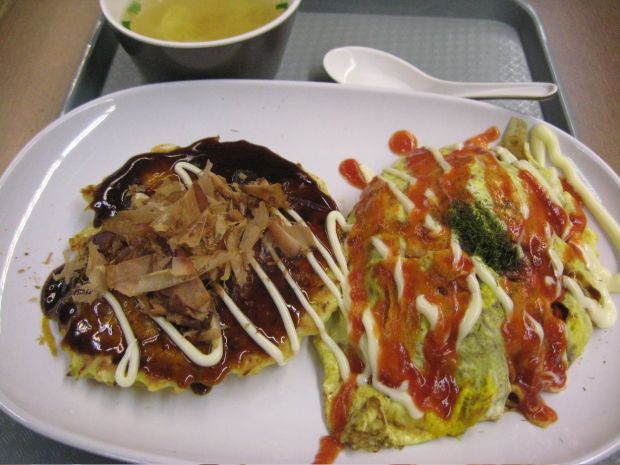 omusoba, around $HK25-40 (the price has completely slipped out my mind). It was very tasty, but the Japanese pancake was pre-made and not hot, and consequently not soft enough, but filled with tasty cabbage and other fillings. I love the cute bonito flakes that squirm around like a gymnast’s cloth swirling around over the lingering warmth, and one must admit it is hard to go wrong with something as deliciously simple as omusoba (ketchup and Kewpie mayonaise helps too 😉 ).
omusoba, around $HK25-40 (the price has completely slipped out my mind). It was very tasty, but the Japanese pancake was pre-made and not hot, and consequently not soft enough, but filled with tasty cabbage and other fillings. I love the cute bonito flakes that squirm around like a gymnast’s cloth swirling around over the lingering warmth, and one must admit it is hard to go wrong with something as deliciously simple as omusoba (ketchup and Kewpie mayonaise helps too 😉 ).
Le Petit Bistro (Sham Shui Po)

Escargot
Tucked into a street that gives an industrial atmosphere, this French restaurant is owned by my aunty’s relatives (again!). Not exactly authentic French food, but I hear that some of the ingredients are sourced from France, and the cosy atmosphere makes it a pleasure to dine in. The set menus are the best value: soup, entree, main and dessert for $HK80?, with cream of spinach (not cornstarchy, but made with real cream!)/tomato boullion (I do remember eating a mussel broth last year which was fantastic), pan-fried duck breast salad/escargot atop mashed potato for entree (not the most photogenic of foods, but it’s tasty, and not slimy at all!), a large range of hearty mains (many pastas, I ordered a creamy fettucine), and dessert of which I highly recommend the baked chocolate mousse: slightly charred, chewy layer that cracks to reveal a hot, creamy and airy sighs of chocolate mousse within; it’s a delightfully enchanting treat. Other picks include butter-sauteed button mushrooms (butter and herb go together like (wait.. thinking of a witty analogy here… yes…still thinking…), okay.. you know what I mean…
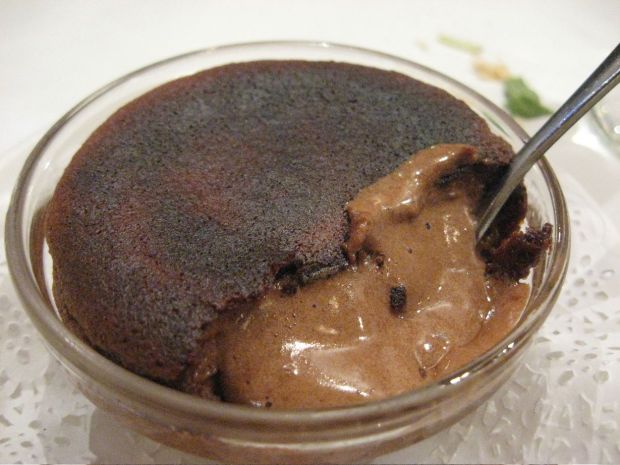
Din Tai Fung 鼎泰豐 (Tsim Sha Tsui)

As a sequel to my trip to this acclaimed restaurant chain in Sydney, my foodie aunt brought me to Din Tai Fung in Tsim Sha Tsui, the only one store in Hong Kong. The decor was not as embellished as Sydney’s, being less modern and more traditional, and it was located on the top floor of the shopping centre which they exploited with a continuous wide window offering a panorama of the multi-storeyed building from above.
A word of advice: come early to avoid the rush! We arrived at 12 or so, and it must have been a slow day, because there were actually seats remaining the hour later when we left, unlike Sydney where there was a long queue (the restaurant here was, smart of them, much larger than Sydney’s). Browsing the menu, we decided to (of course) order the signature xiao long bao, as well as some other dishes. Xiao long bao was just as good as Sydney’s standards (if not better… I don’t know, that’s what you can probably assume considering Hong Kong is supposed to be more expert when it comes to food?), but the highlights for me were the other foods.

A very distinctive entree was the ‘shredded special vegetable and tofu’ (translation is probably off), which wasn’t offered in Sydney’s branch. Tiny pieces of minced firm tofu and the ‘special vegetable’ (don’t even know the name in English! Must be a rather rare plant) flavoured with sesame oil and adorably moulded as a dome. The taste was very unique, resembling the 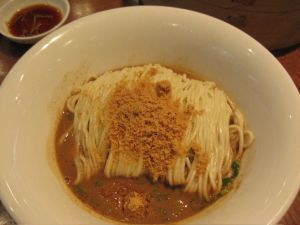 taste of spinach, but with a slightly crisp texture rather than gooey (it’s not raw), the mouthfeel was great: cold and refreshing with a big surface area to savour the sensation. Taiwanese-style dan dan noodles came next: a neat bundle of lai mein (拉麵) surrounded with a rich, spicy peanut sauce sprinkled with ground peanuts. It was a lovely explosion of intense peanut flavour, with sweet, spicy, savoury and nutty notes playing together. I really lked the smoothness of the springy noodles and the silky, sticky sauce that coated it. One thing I recommend though, don’t ask for ‘less spicy’ unless
taste of spinach, but with a slightly crisp texture rather than gooey (it’s not raw), the mouthfeel was great: cold and refreshing with a big surface area to savour the sensation. Taiwanese-style dan dan noodles came next: a neat bundle of lai mein (拉麵) surrounded with a rich, spicy peanut sauce sprinkled with ground peanuts. It was a lovely explosion of intense peanut flavour, with sweet, spicy, savoury and nutty notes playing together. I really lked the smoothness of the springy noodles and the silky, sticky sauce that coated it. One thing I recommend though, don’t ask for ‘less spicy’ unless  you can’t tolerate any heat, because there was hardly any hotness to it. The cute coral-shaped dumplings in the picture are “Sticky rice and pork mince siu mai”, which were very interesting, but because we had so much to eat we had left it to cool for a few minutes, which made the skin a little tough. I thought it was nice anyway, a very novel dish. We also had a hot and sour soup which I didn’t take a picture of, which tasted very authentic (spicy!). Lastly, we ended with a sweet note of black sesame dumpling, which was recommended over the red bean dumpling that my aunty said wasn’t good. The black sesame dumpling was cut into three (as we were all stuffed after finishing the savoury), exposing the hot, molten black sesame paste enclosed in the bun. The paste was just right: rich, smooth yet slightly gritty with finely ground black sesame, with a very aromatic black sesame kick.
you can’t tolerate any heat, because there was hardly any hotness to it. The cute coral-shaped dumplings in the picture are “Sticky rice and pork mince siu mai”, which were very interesting, but because we had so much to eat we had left it to cool for a few minutes, which made the skin a little tough. I thought it was nice anyway, a very novel dish. We also had a hot and sour soup which I didn’t take a picture of, which tasted very authentic (spicy!). Lastly, we ended with a sweet note of black sesame dumpling, which was recommended over the red bean dumpling that my aunty said wasn’t good. The black sesame dumpling was cut into three (as we were all stuffed after finishing the savoury), exposing the hot, molten black sesame paste enclosed in the bun. The paste was just right: rich, smooth yet slightly gritty with finely ground black sesame, with a very aromatic black sesame kick.

Presentation was impeccable, as would be expected with an award-winning restaurant, food is of a consistently high standard (no matter which country you visit!), and price is reasonable.
Tsui Wah Restaurant 翠華餐廳 (Central, Causeway Bay, Aberdeen, Tsuen Wan, Tsim Sha Tsui)
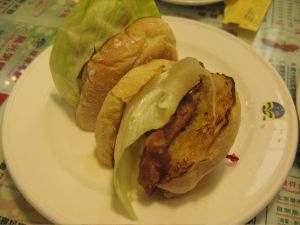 This chain of restaurants is perhaps the epitome of typical no-frills chain of cha chan teng in HK. The menu is very extensive, exemplified by the countless sheets of different menus scattered haphazardly underneath the glass slide of the table, with lots of set meals of rice and noodles. My second aunty brought me here to sample their signature pork chop crispy bun and crispy bun with condensed milk ($20? and $12 respectively). Made
This chain of restaurants is perhaps the epitome of typical no-frills chain of cha chan teng in HK. The menu is very extensive, exemplified by the countless sheets of different menus scattered haphazardly underneath the glass slide of the table, with lots of set meals of rice and noodles. My second aunty brought me here to sample their signature pork chop crispy bun and crispy bun with condensed milk ($20? and $12 respectively). Made 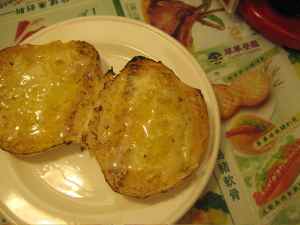 with extra large dome-shaped halves of a bun very similar to the “English muffins” you’d find in Australian supermarkets or McMuffins (slightly chewy bread dusted with a little powder) enhanced with toasting it to a lovely crunch with browned edges, and sandwiched with flavourful pan-fried pork chop, mayo and lettuce, or slathered with generous pools of butter and condensed milk. Cut in half, they make for a nice shared lunch with a friend, the ‘main’ and the ‘dessert’ made from the same base!
with extra large dome-shaped halves of a bun very similar to the “English muffins” you’d find in Australian supermarkets or McMuffins (slightly chewy bread dusted with a little powder) enhanced with toasting it to a lovely crunch with browned edges, and sandwiched with flavourful pan-fried pork chop, mayo and lettuce, or slathered with generous pools of butter and condensed milk. Cut in half, they make for a nice shared lunch with a friend, the ‘main’ and the ‘dessert’ made from the same base!
Super Star Seafood Restaurant 鴻星海鮮酒家 (Wan Chai, Causeway Bay)
This chain of restaurants is quite famous in Hong Kong as serving high-class fine Chinese food, winning many local culinary awards. I have been to the Causeway Bay (Times Square) and Wan Chai restaurants, both of which have the highly embellished theme characteristic of fancy Chinese restaurants. Excuse the lack of photos; the presentation of the dishes were very winsome, but I was with a large group of family and thought it might be strange if I took pictures of the 15+ dishes we ordered!
We were greeted with their iconic appetiser of crispy deep-fried whitebait fish, while the menu boasts a dazzling array of bizarre, exotic, decadent delights, including this (warning: picture may frighten!), like shark fin, abalone, fish maw, sea cucumber and stone fish. Perhaps feeling not so adventerous, my dining companions ordered more down-to-earth dishes that seemingly never-endingly came in a banquet-like fashion, like a claypot stew with vegetables and beancurd sheets (so tasty! I love beancurd sheets), deep-fried fish soaked in thick sauce (a bit too much batter for my liking), scrambled egg whites with large succulent prawns (smooth and light-tasting), yi mein (Chinese E-Fu egg noodles 伊麵) (just the right texture), and the star of the night (for me anyway): braised pomelo skin with scallops or some other sort of seafood. I say ‘some other sort of seafood’ because it was the pomelo skin that shined through! It is oh-so-nice, with an amazingly melt-in-mouth tenderness, flavoured with an oyster sauce that gives some savoury to the otherwise bland taste of pomelo skin. I tried to look up a recipe on the net, and apparently it involves scraping the yellow rind off, soaking in water for a few days, occasionally squeezing it to render the spongey toughness to a more pulpy texture, and then braising with oyster sauce.
Each main dish costs around $HK75-$170. The banquet was concluded with yet another banquet of desserts: a sweet soup of glutinous red rice and coconut milk, the usual platter of fresh cut fruits, New York cheesecake (creamy and cheesy) and steamed creamy (molten) egg custard bun. The custard bun was lovely, hot and truly had a molten liquid core of smooth creamy, eggy custard, enclosed in a soft bun (that was yellow! usually it’s white).

I even had the honour of having a souvenir to take home: my aunty gave me 5 packets of their crispy whitebait, with various flavours of original, curry, tomato, spicy, and seaweed (my favourite), bulked with super crunchy peanuts. I later saw that they sold it in supermarkets too! Best of all, this is not considered contraband by customs, despite being an animal product.
Kowloon Tong Club Cafe (Kowloon Tong)
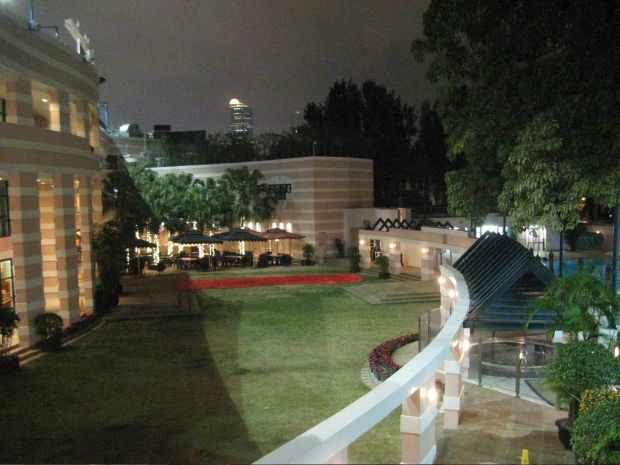
View from another part of building
Apparently Bruce Lee used to live in this wealthy, expat-dominated classy suburb. The buildings here are considerably shorter and classier than the tall, homogenous skyscrapers in the less wealthy areas, with only 2-4 storeys high. This modern, exclusive club reflects the prestige of the suburb, with beautiful fountains on the side of the entrance, and swanky, hotel-like decor, which (I think) only membership would permit entry to. Walking along the corridor adorned with framed paintings leads to the restaurant/cafe.

I heard that the Hainan chicken rice here is very good, but I ordered a set menu (around $HK100?) of entree with grilled tuna salad and fettuccine with cream sauce and cured salmon. The tuna was a bit dry and the edible bones maybe increased its throat-tickling factor, but maybe tuna itself is a fairly dry fish especially when grilled. The pasta was nice, cooked al dente (unlike the soggy  stuff that Canto restaurants make) with lots of cream sauce (look at the pool!), capsicum, mushrooms, and the cured salmon, although very salty, gave a nice texture and contrasting piquancy cut the richness of the sauce. I also ate some wonton noodles which tasted excellent, the wontons filled with plump juicy prawn and meat, and the noodles sufficiently springy, and a cake which was light-textured.
stuff that Canto restaurants make) with lots of cream sauce (look at the pool!), capsicum, mushrooms, and the cured salmon, although very salty, gave a nice texture and contrasting piquancy cut the richness of the sauce. I also ate some wonton noodles which tasted excellent, the wontons filled with plump juicy prawn and meat, and the noodles sufficiently springy, and a cake which was light-textured.
Jade Leaf Desserts 玉葉甜品 (Soho, Central)
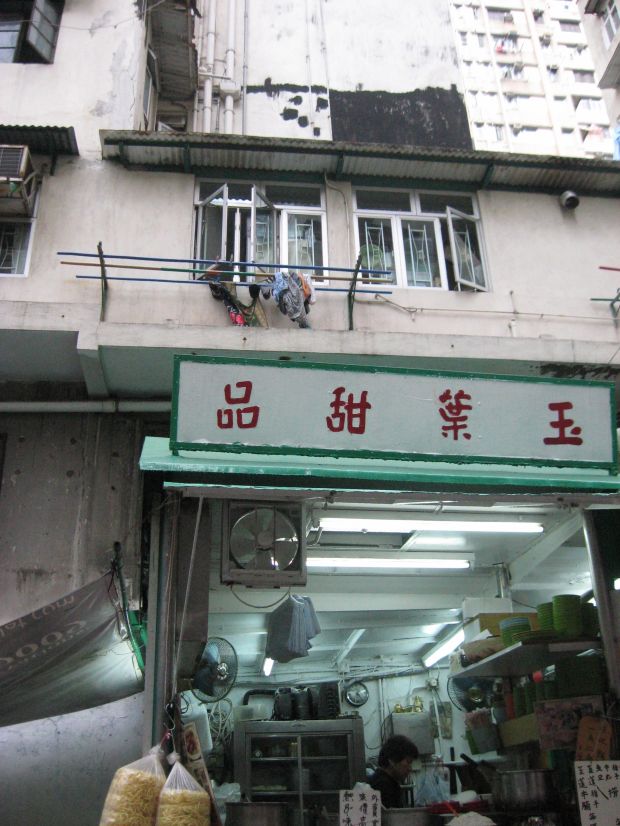
One of the few remaining truly authentic dai pai dongs (大牌檔) in Hong Kong, this adorably unpretentious sidestreet food stall is on one of Soho’s many steep slopes, making the seating uncomfortably slanted. This place would probably be a local’s secret, as I’m sure any tourist may be a bit put off by the scruffiness, and indeed it was my cousin who brought me here. The little ‘shed’ is located adjacent to the outdoor no-frills dining area with fold-up stools and tables barely shielded from the elements by an overhanging fabric canopy.

The stall sells a range of quintessential Hong Kong goodies like sweet soup and noodles, all priced at a bargain of $HK7 (hot) sweet soup, $7.50 (cold) sweet soup (thought it was strange that the nicer one would be more expensive, but figured that refrigeration costs money), and less than $20 for other savoury meals (which the shop is also quite popular for).
海帶綠豆沙 (seaweed green bean soup) was very nice, the thick strips of smooth seaweed imparting a gentle flavour and slippery texture to the soup. 香草綠豆沙 (herb green bean soup) which was served cold, tasted a bit weird to me, maybe because I don’t particularly like herby tastes in sweet food, and I also think that sweet soup tastes better hot since the sweetness and flavour is  more strongly detectable. My cousin found a piece of newspaper in the soup, but a waiter was happy to replace. I think they use newspaper somehow in the preparation process, like they did in the old days before food sanitation was a worry, but I’m not too alarmed, since everything is made the traditional, home-style method; there are much worse things that could have come into contact with food! 芝麻糊 (black sesame soup) tasted as if the black sesame had been a little burnt, but not too much so, and the texture of the gritty black sesame was just right, not watered down. The 糖不甩 (“sugar won’t come off’ literally translated) ($HK8) hot, chewy, plump glutinous rice flour balls coated with desiccated coconut, sugar and white sesame seeds, tastes so good, but then this is also something easily emulated at home. The tong sui (sweet soup) were a little on the sweet side, and they are made in a crude manner, probably resulting in many inconsistencies in the cooking, but that’s what sets it apart as authentic from the generic ‘dessert food stalls’ in shopping centres. It’s also a lot in part to do with the experience of eating at a traditional HK stall with all the old-world charm: my cousin said that by the next time I visit Hong Kong, this stall may have closed down already (because ownership can’t be transferred to other family’s hands. or something along those lines)!
more strongly detectable. My cousin found a piece of newspaper in the soup, but a waiter was happy to replace. I think they use newspaper somehow in the preparation process, like they did in the old days before food sanitation was a worry, but I’m not too alarmed, since everything is made the traditional, home-style method; there are much worse things that could have come into contact with food! 芝麻糊 (black sesame soup) tasted as if the black sesame had been a little burnt, but not too much so, and the texture of the gritty black sesame was just right, not watered down. The 糖不甩 (“sugar won’t come off’ literally translated) ($HK8) hot, chewy, plump glutinous rice flour balls coated with desiccated coconut, sugar and white sesame seeds, tastes so good, but then this is also something easily emulated at home. The tong sui (sweet soup) were a little on the sweet side, and they are made in a crude manner, probably resulting in many inconsistencies in the cooking, but that’s what sets it apart as authentic from the generic ‘dessert food stalls’ in shopping centres. It’s also a lot in part to do with the experience of eating at a traditional HK stall with all the old-world charm: my cousin said that by the next time I visit Hong Kong, this stall may have closed down already (because ownership can’t be transferred to other family’s hands. or something along those lines)!












 The food was really good with a modern atmosphere. I had squid ink spaghetti with grilled chicken breast fillet and tomato sauce (look how black it is!! Usually it’s grey-ish.. I wonder if it’s because of food colouring or generosity in putting in more ink?). The chicken was so nice and very smooth (smoothest chicken breast I’ve tasted), the tomato sauce complemented the chicken well, the spaghetti was coated in lots of oil and
The food was really good with a modern atmosphere. I had squid ink spaghetti with grilled chicken breast fillet and tomato sauce (look how black it is!! Usually it’s grey-ish.. I wonder if it’s because of food colouring or generosity in putting in more ink?). The chicken was so nice and very smooth (smoothest chicken breast I’ve tasted), the tomato sauce complemented the chicken well, the spaghetti was coated in lots of oil and  garlic. I don’t think ink spaghetti tastes much different to normal spaghetti, it just looks adorable, and a bit rich and creamy. My friend had a baked fish fillet in spinach cream sauce over rice, it looks really tasty and probably something that could be re-created at home.
garlic. I don’t think ink spaghetti tastes much different to normal spaghetti, it just looks adorable, and a bit rich and creamy. My friend had a baked fish fillet in spinach cream sauce over rice, it looks really tasty and probably something that could be re-created at home.
